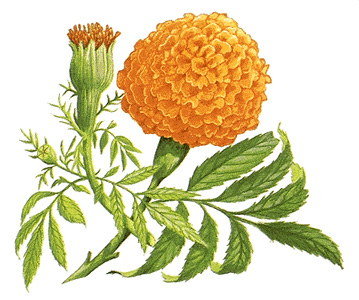Marigold is a hardy flowering plant commonly grown in gardens. Marigolds range from 6 inches to 3 feet (15 to 90 centimeters) in height. They generally have yellow, orange, or reddish-brown blossoms and feathery, fernlike leaves. Most have a strong odor. All cultivated marigolds are annuals—that is, they live for only one year.
There are about 50 species of marigolds. Six of these species are commonly cultivated: (1) African, also called Aztec or big, (2) French, (3) sweet-scented, (4) signet, (5) Irish lace, and (6) Muster-John-Henry. All marigolds are native to an area that extends from the Southwestern United States to Argentina. Spanish explorers brought marigolds to Europe in the early 1500’s.

Marigolds are easy to grow. They can survive dry weather better than most other garden flowers can. Some marigolds produce an oil that repels nematodes, small worms that live as parasites on plant roots. Gardeners may grow such marigolds with other plants to protect those plants from nematodes.
